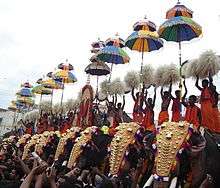Temple elephant
Temple elephants are a type of captive elephant. Temple elephants are usually wild animals, poached from the forests of North East India from wild herds at a young age and then sold into captivity to temples and other private buyers. These elephants form a vital part of the socio-economic framework of many temple ceremonies and festivals in India, particularly in South India. Many major temples own elephants; others hire or are donated elephants during the festive seasons. It is estimated that India has an approximate wild elephant population of only 25 - 28,000 animals. Another 2,500-3000 elephants are held in different types of captivity like in zoos, circuses, temples, tourism etc. Of these, approximately 500-600 are held in captivity in Kerala, the southern Indian state. The Indian elephant population has actually decreased from around 100,000 at the early part of the 20th century; widespread poaching of adult elephants for ivory and for the craze of tuskers in Kerala has wiped out entire herds, leading to trauma and lack of cohesion and adjustment among the younger male wild population.
The largest elephant farm in India is Punnathurkotta of the temple of Guruvayur; it has about 59 captive elephants; it currently houses 58 captive elephants, of which 53 are adult males and 5 are females.
Gallery on elephants

 The colored umbrellas and peacock quill decorated fans used with caparisoned elephants.
The colored umbrellas and peacock quill decorated fans used with caparisoned elephants.
 Caparisoned elephants during Sree Poornathrayesa temple festival.
Caparisoned elephants during Sree Poornathrayesa temple festival. Caparisoned elephants during Sree Poornathrayesa temple festival.
Caparisoned elephants during Sree Poornathrayesa temple festival. Caparisoned elephants during Sree Poornathrayesa temple festival.
Caparisoned elephants during Sree Poornathrayesa temple festival. Caparisoned elephants during Sree Poornathrayesa temple festival.
Caparisoned elephants during Sree Poornathrayesa temple festival. Caparisoned elephants during Sree Poornathrayesa temple festival.
Caparisoned elephants during Sree Poornathrayesa temple festival. Caparisoned elephants during Sree Poornathrayesa temple festival.
Caparisoned elephants during Sree Poornathrayesa temple festival. Caparisoned elephants during Sree Poornathrayesa temple festival.
Caparisoned elephants during Sree Poornathrayesa temple festival. Caparisoned elephants during Sree Poornathrayesa temple festival.
Caparisoned elephants during Sree Poornathrayesa temple festival. Caparisoned elephants during Sree Poornathrayesa temple festival.
Caparisoned elephants during Sree Poornathrayesa temple festival. Caparisoned elephants during Sree Poornathrayesa temple festival.
Caparisoned elephants during Sree Poornathrayesa temple festival.
See also
- Captive elephants
- Animal worship
- Cultural depictions of elephants
- Elephant
- Elephants in Kerala culture
- Guruvayur Keshavan
- Thrissur Pooram
External links
| Wikimedia Commons has media related to Temple elephants. |
- Temple Elephants Video A short QuickTime video of Elephants from Tiruvannamalai, Sri Rangam and elsewhere.